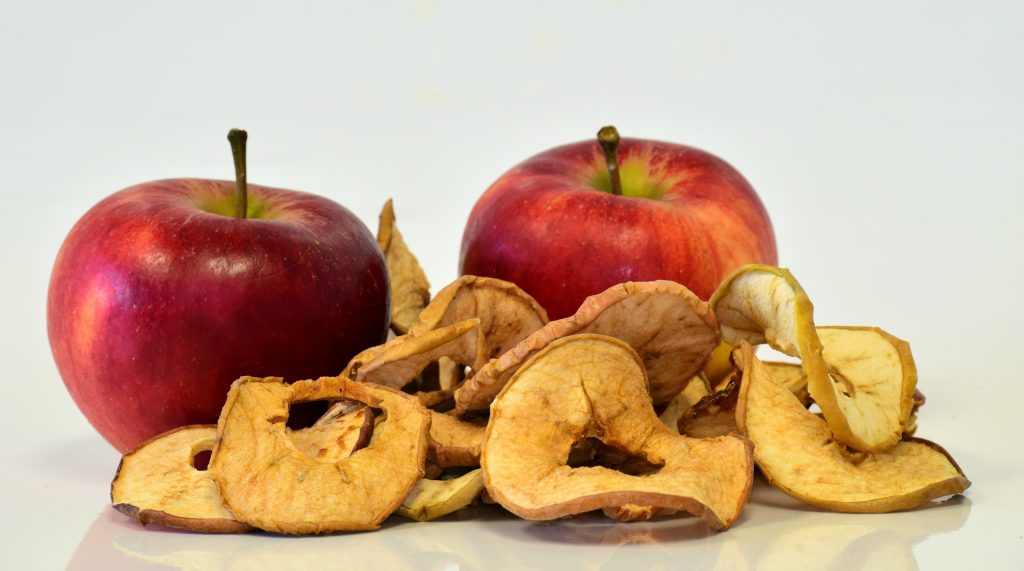
Dehydrating is one of the oldest, most affordable and simple methods of preserving food. It preserves food by drying, using low heat and air flow to remove water from food so bacteria, mold and other pathogens can’t live on or in it. Drying shrinks food, concentrates flavour and keeps most of the nutrients, making it an easy and convenient way to keep nutritious food for an extended time.
Food can be dried in the sun, in an oven at low temperature, by hanging in a dry, well-ventilated area or in an electric dehydrator. While the cost may be highest with an electric dehydrator, they are the fastest, easiest and most convenient way to get consistent results.
What Foods Can be Dehydrated?
Some foods are easier to dehydrate than others. Fruits, vegetables, herbs, beans and grains are easier to dehydrate than meats, eggs and whole meals that require more careful preparation for good, safe results.
Food that should not be dehydrated are high fat foods. Fat does not dehydrate, therefore fats and foods high in fat (dairy, fatty meats, sauces with oil, some nuts and seeds, avocado, etc.) are not suitable for drying. Fat leaves an oily film on food and will cause food to go rancid quickly.
If you do not enjoy the flavour of a food before it is dehydrated, you will not prefer it dried. Dehydrating does not change the flavour of food but results in food with concentrated flavour. Therefore, only use tasty, high quality food and fresh, ripe produce for dehydrating.
General Steps for Dehydrating Food using a Dehydrator
- Select and prepare high quality food. Preparation may include washing, separating, pitting, cutting, peeling, piercing skins, etc.
- Pre-treat food (blanch, cook, marinade, etc.) as indicated in specific recipes to ensure safety, long-lasting quality and proper re-hydration. Most vegetables require blanching while meats and eggs need to be cooked or otherwise prepared.
- Pat dry and remove any surface moisture from food before placing it in the dehydrator.
- Place items evenly on trays, without overlapping food to ensure good air flow. Set the temperature and dry for the time given in the recipe (4-12 hrs). Do not be tempted to turn up the heat to speed up drying times. Higher temperatures will dry and harden the outside of the food leaving moisture trapped in the middle. This is called “case hardening” and can lead to mold and spoiled food. Always use the recommended temperature.
- Check for desired dryness as follows.
Fruits should be pliable and leathery with no moisture beads when cut.
Herbs should be brittle and easy to crumble.
Vegetables should be leathery to brittle.
Grains and legumes should be brittle and shatter if hit.
Meats should be hard, dark and break apart.
If you are unsure, it is better to over-dry rather than under-dry. - Remove food from the dehydrator and let it cool for at least two hours (and even overnight) to avoid any condensation when storing. Store it in a sealed jar or container where any remaining moisture will be distributed equally among the dried food pieces. Watch for at least 10 days to ensure there is no moisture (pieces will stick together or look moist). If there is moisture, you need to return it to the dehydrator, or store it in the freezer to prevent spoiling.
- Well-dried food should be stored in sealed containers in a dark, cool place (10°C/50°F). Keep away from any sources of heat or sunlight. If you have any doubts about the fat content or dryness of your food, store it in the freezer for maximum shelf life.
Getting Started with Recipes
If you’re new to dehydrating, here are some great recipes from trusted sources to try in your dehydrator:
Dried Apple Rings
Apple Rhubarb Fruit Leather
Dehydrated Apple Almond Snack Bars
How to Dehydrate Carrots
How to Dry Rice for Instant Rice
How to Dehydrate Basil
Meat Jerky
Other Methods of Drying Food
Although an electric dehydrator is very convenient, there are a few other ways to accomplish the same goal of drying and preserving foods. These alternate methods are discussed in “Out to Dry: An Urban Bushwoman’s Guide to the Traditional Art and Science of Food” a booklet by traditional foods educator Audrey Logan.
Indigenous peoples have been drying foods for centuries, and the Dehydration Nations group looks to share and build this traditional knowledge. If you are interested in learning more about using dried foods in your diet, join the Dehydration Nation Facebook group for plenty of ideas and inspiration.
Other Resources
Drying Fruits and Vegetables from Love Food Hate Waste Canada
Drying Food from the National Center for Home Food Preservation (NCHFP)
Top Twelve Tips for Dehydrating Food and How to Store Dried Food from home economist, Getty Stewart.
Read these articles next:
What’s in Season on the Prairies
Grow Your Own Food






